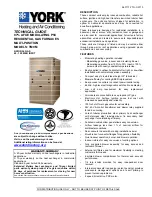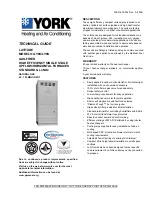
8
1.
IMPORTANT:
If using a cooling evaporator coil with this fur-
nace, be sure the air passes over the heat exchanger before
passing over the cooling coil. The cooled air passing over the
warm ambient air inside the heat exchanger tubes can cause
condensation inside the tubes resulting in corrosion and even-
tual failure. An auxiliary drain pan should extend under any
evaporator coil installed with the furnace.
If there are manual dampers, they must be equipped to prevent
heating or cooling operation unless the damper is in the full heat
or cool position.
2.
NOTE:
This furnace is shipped with heat exchanger support
brackets installed under the back of the heat exchanger. These
may be removed before installation, but it is not required.
3. IMPORTANT:
This furnace is not approved or recommended
for installation on its back, with access doors facing upwards.
4. This furnace is suitable for installation in buildings constructed
on-site. This heating unit should be centralized with respect to
the heat distribution system as much as practicable.
5.
NOTE:
These furnaces are approved for installation in attics,
as well as alcoves, utility rooms, closets and crawlspaces.
6.
IMPORTANT
:
Support this unit when installed. For attic or crawl
space installation, horizontal furnaces may be installed on com-
bustible wood flooring or by using support brackets. See Figure
3.
7.
IMPORTANT
:
If installing in a utility room, be sure the door is
wide enough to:
a. allow the largest part of the furnace to pass; or
b. allow any other appliance (such as a water heater) to pass.
SITE SELECTION
1. Select a site in the building near the center of the pro-
posed, or existing, duct system.
2. Give consideration to the vent system piping when se-
lecting the furnace location. Be sure the venting system
can get from the furnace to the termination with minimal
length and elbows.
3. Locate the furnace near the existing gas piping. Or, if
running a new gas line, locate the furnace to minimize
the length and elbows in the gas piping. See Figure 3.
4. Locate the furnace to maintain proper clearance to
combustibles as shown in following Figure 4.
CLEARANCE – ACCESSIBILITY
The design of forced air furnaces with input ratings as
listed in the tables under Figure 4 are to combustible mate-
rials shown in inches.
See name/rating plate and clearance label for specific
model number and clearance information.
Service clearance of at least 24 inches (30 cm) is recom-
mended in front of all furnaces.
NOTE:
Use recommended 24” (30 cm) clearance if accessi-
bility clearances are greater than fire protection clearances.
ACCESSIBILITY CLEARANCES, WHERE GREATER, MUST
TAKE PRECEDENCE OVER FIRE PROTECTION CLEAR-
ANCES.
GENERAL INFORMATION
LOCATION REQUIREMENTS
Lo
ca
tio
n
!
WARNING
WHEN THIS FURNACE IS INSTALLED IN A RESIDENTIAL
GARAGE, IT MUST BE INSTALLED SO THE BURNERS
AND IGNITION SOURCE ARE LOCATED NO LESS THAN
18 INCHES [450MM] ABOVE THE FLOOR. THIS IS TO PRE-
VENT THE RISK OF IGNITING FLAMMABLE VAPORS
WHICH MAY BE PRESENT IN A GARAGE. ALSO, THE FUR-
NACE MUST BE LOCATED OR PROTECTED TO AVOID
PHYSICAL DAMAGE BY VEHICLES. FAILURE TO FOLLOW
THESE WARNINGS CAN CAUSE A FIRE OR EXPLOSION,
RESULTING IN PROPERTY DAMAGE, PERSONAL INJURY
OR DEATH.
!
WARNING
THIS FURNACE IS NOT APPROVED OR RECOMMENDED
FOR INSTALLATION ON ITS BACK, WITH ACCESS DOORS
FACING UPWARDS.
!
WARNING
DO NOT LIFT THE UNIT BY THE HEAT EXCHANGER
TUBES. DOING SO CAN DAMAGE THE HEAT EX-
CHANGER ASSEMBLY.
Summary of Contents for 801MSP Series
Page 52: ...52 CM 0614 ...









































